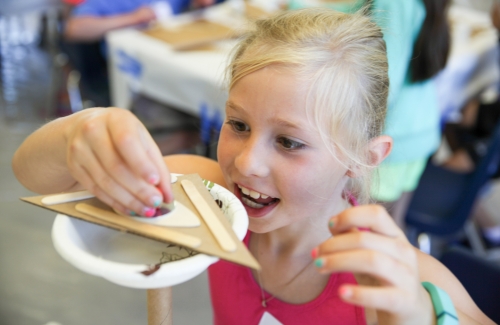Using Science Journaling for Elementary Students to Emphasize the Power of Observation

For centuries, science journals have provided thinkers a place to record their thoughts and ideas, to revise and build on them as they conducted research and created prototypes. Many of the world’s foremost scientists and prolific inventors—including the likes of Galileo Galilei and Leonardo Da Vinci—have used journals.
Inside, they scribbled their notes, sketched their diagrams, and doodled their designs. They made flowcharts and graphs, recorded their ideas, and drew up plans. Galileo filled his journal with notes and drawings depicting observations made with his telescope. Da Vinci recorded his work on topics ranging from anatomy to art and architecture to warfare. Notable Notebooks: Scientists and Their Writings, by Jessica Fries-Gaither, takes kids inside the science journals of visionaries who have changed the world through their work.
Science journaling is a time-honored method, and it’s not just for grown-ups. Elementary students can use the practice to record their learnings and harness the power of observation.
Why Observation is Important
Observation is a skill that can save lives and help us recognize opportunities. Though we often think of observations as that which we have seen with our eyes, observations may be made with any of the five senses. Experiencing the world through multiple sensory observations increases our learning as it engages multiple learning modalities. Observations may be qualitative (descriptive) or quantitative (involving measurement and numbers).
Helping kids develop their powers of observation is a useful and protective skill we can share. Careful observation can alert us to danger and keep us safe. Failure to notice opportunities can cost us the chance for positive outcomes. We can model the power of observation for kids by pointing out things we perceive with our senses, and we can prompt them to make observations by asking specific questions. Careful observation helps kids learn about their world. Talking and writing about their observations creates neural connections that strengthen understanding.
Getting Started with Science Journaling
Once kids are in tune with their power of observation, helping them start a science journal provides a place to record everything that they are experiencing. Here are a few considerations:
Type of journal
Help your budding scientist choose a journal: spiral bound, stitched or loose pages; blank, lined or graph paper pages. If they plan to use markers or watercolor paints, a sketchbook with heavier pages is appropriate. Younger kids will benefit from wider lines with blank space in which to sketch. This engages and encourages kids’ emerging language skills; drawings and “invented” spelling should be accepted and celebrated.
Format
Kids can decide whether to divide their journal into sections, each designated for a specific purpose: notes, drawings, etc. or to mix content and organize it sequentially by date. Small sticky tabs could mark each section.
Media
Kids can use a variety of media to record their observations. Colored pencils, markers and paint will allow them to create a colorful journal entry. Erasing is not necessary as changes can be added as new entries. It is easy to dry and press specimens, including leaves, four-leaf clovers and wildflowers between the pages of a journal.
Location
Science journals have gone to space, on safaris and to sea; they can be found in labs, observatories and workshops. Make sure kids have a safe place to store their journal, so it is accessible when they need it for a walk in the woods, a trip to the beach or an adventure at the zoo.
Electronic journals
For kids who prefer to record their observations electronically, Google has a journaling app. Available as a free download for Android or iOS, Science Journal is a digital science notebook that allows users to measure light, sound, acceleration and air pressure by interfacing with their device’s built-in sensors. Users can record text, connect to external sensors via Bluetooth-enabled Arduino devices and use the device’s camera to add photos to their journal. Elementary kids can choose from experiments and activities provided or create their own.
Journals Create a Permanent Record
Creating a special journal helps convey the message that kids’ writings and drawings have value. As they record and date their observations, they are creating a unique artifact to which they can refer back. Besides creating lasting memories, they can track changes in their ideas and changes in their world over time. An example is climate scientist Dr. Lonnie Thompson who demonstrated climate change by recording his observations of glacier retreat over several decades. Inventors, too, can record failed attempts and propose future changes. Thomas Edison standardized his journaling process to keep track of his nearly 1100 patented inventions.
We have learned a great deal about scientists and inventors from the writings and drawings they left in their notebooks. Beatrix Potter recorded very detailed watercolor paintings of plants, animals and mushrooms, and later used them to illustrate children’s books. Her very accurate scientific drawings of fungus have appeared in field guides.
Increasing the Engagement
Kids who enjoy sharing their observations through science journaling would benefit from the empowering experience of an innovation summer camp like Camp Galileo. Each of its exciting hands-on themes will give elementary kids plenty to think and write about as they spend a week in collaborative exploration geared to their age and developmental level.
At Camp Galileo, kids learn to think and act as innovators who can envision and create a better world by building a combination of mindset, process, and knowledge known around camp as the Galileo Innovation Approach (or the GIA). The GIA encompasses the Innovator’s Mindset, which supports innovative thinking; the Innovator’s Process, which will help kids process and implement their ideas; and the Innovator’s Knowledge. This knowledge will help build background and skills for budding scientists and support their future explorations.
Helping kids develop a habit of documenting their ideas and questions in a science journal is a great way to support kids in becoming more observant and reflective. Journaling doesn’t require a big investment; just a little time and attention.
Kids who record their thoughts and ideas in a science journal are in the company of scientists, innovators and inventors who have changed the world. Emphasizing their power of observation and supporting a habit of journaling helps to prepare kids to follow in their footsteps.

 Get Your Kids Off Their Screens and Into These Science Experiments
Get Your Kids Off Their Screens and Into These Science Experiments  Our Favorite DIY Activities for Kids
Our Favorite DIY Activities for Kids  11 Virtual Field Trips You Can Take From Home
11 Virtual Field Trips You Can Take From Home 